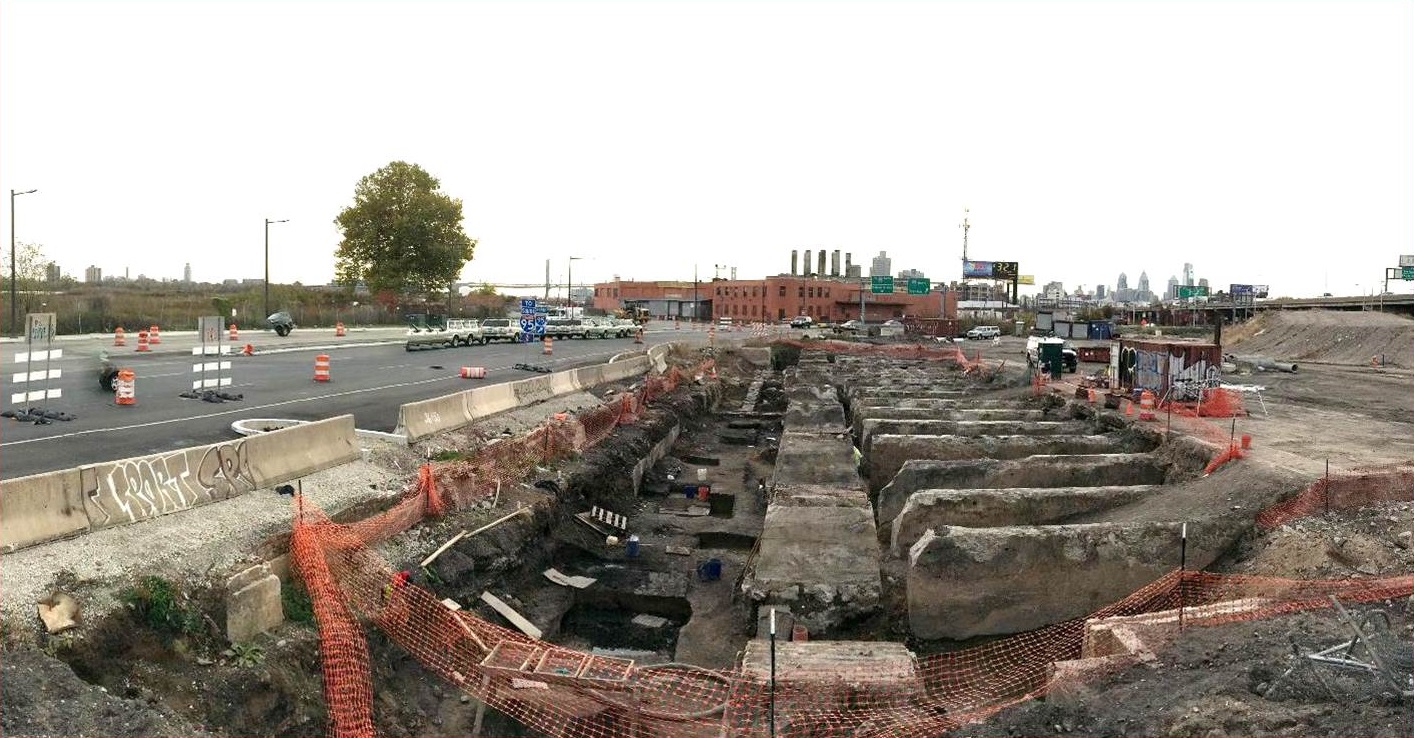Site Page
T3

Explore
T3:
| Site Name | T3 |
| PASS# | 36PH0206 |
| Image | 1 image site overview |
| Dates of Excavation | 2014-2017 |
| Phase of Excavation | Phase I, II and III |
| Number of Test Units | 184 |
| Approximate Number of Features Identified | 23 |
| Associated Periods | Pre-contact: Middle Archaic to Late Woodland period |
| Site Acreage | Approximately 0.92 acres |
Pre-contact artifacts were identified at depths of between 6 and 7 feet below the present ground surface, and were contained in intact soil deposits encountered between the former machine shop’s reinforced concrete foundations. The T3 Site is an extraordinary example of a significant archaeological site that survived despite impacts from subsequent intensive industrial development.
Archaeological investigations revealed that the site was originally created on a low, broad terrace landform adjacent to a meandering stream later known as Gunner’s Run. Initial analysis suggests that this could be the same terrace landform also encountered at the T1 Site, on the eastern side of Richmond Street. Artifacts within the site were recovered from substantially intact ground surface soils (A horizon) and underlying upper subsoil deposits (E and B horizons). Despite the proximity of the Gunner’s Run stream channel, no evidence of stratified soil horizons or artifact deposits were found at this site.
Artifacts within the site were scattered across a broad section of the terrace, but tended to be most densely clustered in areas closest to the adjacent stream channel. Nearly 29,000 pre-contact artifacts were recovered from the site and 23 intact features were also documented. The artifacts are dominated by fire-cracked rock (FCR; almost 24,000 pieces) and a wide variety of tool-manufacturing debris (4,600 items). In addition, 119 bifacially worked tools and nearly 130 other flaked stone tools (utilized and retouched flakes, drills, side and end scrapers) were recovered, as were more than 40 groundstone and cobble tools (hammerstones, manos, mauls, netsinkers, pitted cobbles). Of the bifaces, more than 70 are temporally diagnostic projectile points representing a wide variety of bifurcated, side- and corner-notched, stemmed, teardrop, and triangular forms. Trace amounts of pre-contact pottery were also recovered.
The pre-contact features documented within the site included numerous (and sometimes large) FCR clusters, two hearths/earth ovens, and one large pit. Charcoal recovered from six of these features was submitted for carbon-14 analysis and returned calibrated median dates ranging from 3052 B.C. to A.D. 1724. Collectively, diagnostic artifact forms and carbon-14 dates indicate that Native Americans occupied this site repeatedly from the Middle Archaic (circa 7000 B.C.) through Late Woodland (circa A.D. 1550) culture periods, and possibly also into the early historic period. Investigations of the site produced no evidence of structures or long-term occupation, and it is thought that this site likely represents an intensively utilized procurement site, where activities such as stone-tool manufacture and refurbishment, hunting/fishing, and animal- and plant-food processing were carried out on a seasonal basis.
Site Page
Tumanaranaming 3

| Site Name | T3 |
| PASS# | 36PH0206 |
| Image | 1 image site overview |
| Dates of Excavation | 2014-2017 |
| Phase of Excavation | Phase I, II and III |
| Number of Test Units | 184 |
| Approximate Number of Features Identified | 23 |
| Associated Periods | Pre-contact: Middle Archaic to Late Woodland period |
| Site Acreage | Approximately 0.92 acres |
Pre-contact artifacts were identified at depths of between 6 and 7 feet below the present ground surface, and were contained in intact soil deposits encountered between the former machine shop’s reinforced concrete foundations. The Tumanaranaming #3 Site is an extraordinary example of a significant archaeological site that survived despite impacts from subsequent intensive industrial development.
Archaeological investigations revealed that the site was originally created on a low, broad terrace landform adjacent to a meandering stream later known as Gunner’s Run. Initial analysis suggests that this could be the same terrace landform also encountered at the Tumanaranaming #1 Site, on the eastern side of Richmond Street. Artifacts within the site were recovered from substantially intact ground surface soils (A horizon) and underlying upper subsoil deposits (E and B horizons). Despite the proximity of the Gunner’s Run stream channel, no evidence of stratified soil horizons or artifact deposits were found at this site.
Artifacts within the site were scattered across a broad section of the terrace, but tended to be most densely clustered in areas closest to the adjacent stream channel. Nearly 29,000 pre-contact artifacts were recovered from the site and 23 intact features were also documented. The artifacts are dominated by fire-cracked rock (FCR; almost 24,000 pieces) and a wide variety of tool-manufacturing debris (4,600 items). In addition, 119 bifacially worked tools and nearly 130 other flaked stone tools (utilized and retouched flakes, drills, side and end scrapers) were recovered, as were more than 40 groundstone and cobble tools (hammerstones, manos, mauls, netsinkers, pitted cobbles). Of the bifaces, more than 70 are temporally diagnostic projectile points representing a wide variety of bifurcated, side- and corner-notched, stemmed, teardrop, and triangular forms. Trace amounts of pre-contact pottery were also recovered.
The pre-contact features documented within the site included numerous (and sometimes large) FCR clusters, two hearths/earth ovens, and one large pit. Charcoal recovered from six of these features was submitted for carbon-14 analysis and returned calibrated median dates ranging from 3052 B.C. to A.D. 1724. Collectively, diagnostic artifact forms and carbon-14 dates indicate that Native Americans occupied this site repeatedly from the Middle Archaic (circa 7000 B.C.) through Late Woodland (circa A.D. 1550) culture periods, and possibly also into the early historic period. Investigations of the site produced no evidence of structures or long-term occupation, and it is thought that this site likely represents an intensively utilized procurement site, where activities such as stone-tool manufacture and refurbishment, hunting/fishing, and animal- and plant-food processing were carried out on a seasonal basis.